| Manufacturer: | Public Missiles  |
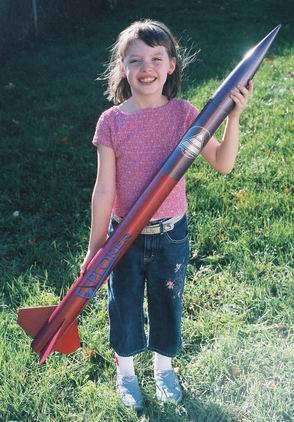 Brief:
Brief:
This beginner friendly kit provides a nice introduction to High Power Rocketry
and level 1 certification. The PML Explorer is one of several kits in PML's VHA
(Very High Altitude) kit line. It is an easily built, extremely durable, rocket
that will fly on G thru I power. This kit is nearly the same as the PML
“Small Endeavor" except for the fins. The Explorer was my prize for
winning the EMRR
“Launcher" photo contest. The kit is available directly from PML
and retails for $62.00. I was able to locate a few retailers that had this and
other PML kits in stock. You may be able to shop around and save a few bucks.
You can also specify either a 29mm or 38mm motor tube when ordering the kit.
The PML website lists hundreds of additional parts and options such as payload
bays, electronics, etc. for your rocket.
Construction:
This is a very straight forward 3FNC kit employing motor ejection to push a
piston. The Kit comes in a strong plastic bag with a bright orange header card
stapled at the top. The packaging, kit materials and instructions are all very
well done. One thing to note is the speed in which PML must have filled the
order and shipped this kit. I notified EMRR of my prize selection on a Monday
morning and the kit arrived at my home Wednesday morning. It was sent UPS
ground from PML in Michigan to Wisconsin. Evidently PML lost no time getting
this package out the door and on its way to me.
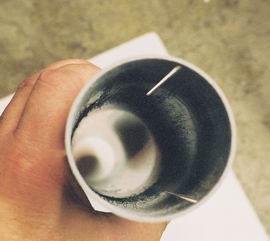 The kit includes a
very heavy duty plastic nose cone, a nice set of G-10 fiberglass fins, and a
36" x 2.5" pre-slotted airframe. PML calls the airframe material
Quantum Tubing. To me it looks a little bit like thin wall gray PVC drain pipe.
At first I thought that I might find something like this at Home Depot or
McMaster Carr, but after some searching, I was unable to locate anything
identical to this material. PML states that the Quantum tubing is NOT strong
enough for supersonic flight and should not be glassed. Glassed phenolic is
recommended for supersonic flight and would be about the same weight as the
Quantum tube. You can “upgrade" the kit to (glassable) phenolic
tubing for free when you place your order. Quantum tubing is somewhat heavy
compared to paper or phenolic tubes. The tube in my kit weighed about 12
ounces. Combine that with a 6.5 oz nosecone and 4.5 oz for the G-10 fins and
you get a relatively heavy rocket for its size. The finished 47" x
2.5" kit will weigh in at about two pounds according to the instructions.
My Explorer weighed 2 pounds 1oz when completed and painted. Instead of calling
this kit heavy, you could call it indestructible. I have no doubt this rocket
will stand up to repeated launches, rough landings, harsh handling, etc. I
doubt that the Quantum Tubing will ever suffer a zipper or “Estes
dent" type of damage. The kit includes a panel sewn 30" rip stop
nylon chute with a built in 5" spill hole. A 36" chute (for hard
surface landings) is a $2 upgrade option.
The kit includes a
very heavy duty plastic nose cone, a nice set of G-10 fiberglass fins, and a
36" x 2.5" pre-slotted airframe. PML calls the airframe material
Quantum Tubing. To me it looks a little bit like thin wall gray PVC drain pipe.
At first I thought that I might find something like this at Home Depot or
McMaster Carr, but after some searching, I was unable to locate anything
identical to this material. PML states that the Quantum tubing is NOT strong
enough for supersonic flight and should not be glassed. Glassed phenolic is
recommended for supersonic flight and would be about the same weight as the
Quantum tube. You can “upgrade" the kit to (glassable) phenolic
tubing for free when you place your order. Quantum tubing is somewhat heavy
compared to paper or phenolic tubes. The tube in my kit weighed about 12
ounces. Combine that with a 6.5 oz nosecone and 4.5 oz for the G-10 fins and
you get a relatively heavy rocket for its size. The finished 47" x
2.5" kit will weigh in at about two pounds according to the instructions.
My Explorer weighed 2 pounds 1oz when completed and painted. Instead of calling
this kit heavy, you could call it indestructible. I have no doubt this rocket
will stand up to repeated launches, rough landings, harsh handling, etc. I
doubt that the Quantum Tubing will ever suffer a zipper or “Estes
dent" type of damage. The kit includes a panel sewn 30" rip stop
nylon chute with a built in 5" spill hole. A 36" chute (for hard
surface landings) is a $2 upgrade option.
The instructions are explicit and detailed with illustrations every step of the way. A beginner would have no trouble constructing this kit. All of the parts were cut or machined very precisely and needed just a little final sanding for a perfect fit. The rocket is assembled with epoxy. I used 5 minute epoxy, but epoxy with a longer set time would work just as well. All surfaces to be bonded must be scuffed with 120 grit sandpaper. This is especially true when bonding anything to the Quantum Tubing airframe. The kit is constructed in nine steps and took me one Saturday afternoon to complete.
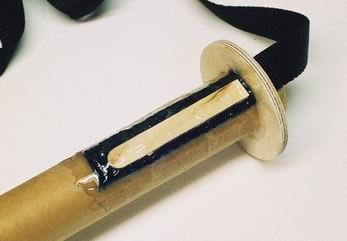 Step 1 - Gluing the
upper centering ring to the motor tube. This is a standard 29mm paper motor
tube and a ¼" inch plywood centering ring. The lower centering ring
is installed in step 4.
Step 1 - Gluing the
upper centering ring to the motor tube. This is a standard 29mm paper motor
tube and a ¼" inch plywood centering ring. The lower centering ring
is installed in step 4.
Step 2 - Gluing the piston strap to the motor tube. The piston strap is a wide piece of tubular nylon. I used a Popsicle stick embedded in the epoxy as a “rebar".
Step 3 - Gluing the motor mount to the airframe. Make sure to scuff the inside of the airframe to help the epoxy to adhere to the Quantum Tubing. This is pointed out in the instructions, but is worth repeating. The polymer tube material is quite smooth in its manufactured state.
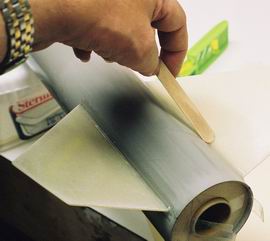 Step 4 (The most
complex step.) Installing the fins, making inside and outside fillets, and
gluing the lower centering ring. To make finishing easier, I did some light
sanding of the airframe with 400 grit sandpaper. I also sanded the fins and
rounded the edges before gluing them in place. Inside epoxy fillets are the
hardest part of the construction. Using 12 minute epoxy (sold by PML and many
hobby shops) would have made this a little easier. I used 5 minute epoxy, which
meant that I had to mix smaller batches and work quickly to get the epoxy in
place and smoothed out before it started to set-up. I used a lot of Popsicle
sticks to mix and spread the epoxy. The rounded end of a Popsicle stick can
also be used to help make uniform external fillets.
Step 4 (The most
complex step.) Installing the fins, making inside and outside fillets, and
gluing the lower centering ring. To make finishing easier, I did some light
sanding of the airframe with 400 grit sandpaper. I also sanded the fins and
rounded the edges before gluing them in place. Inside epoxy fillets are the
hardest part of the construction. Using 12 minute epoxy (sold by PML and many
hobby shops) would have made this a little easier. I used 5 minute epoxy, which
meant that I had to mix smaller batches and work quickly to get the epoxy in
place and smoothed out before it started to set-up. I used a lot of Popsicle
sticks to mix and spread the epoxy. The rounded end of a Popsicle stick can
also be used to help make uniform external fillets.
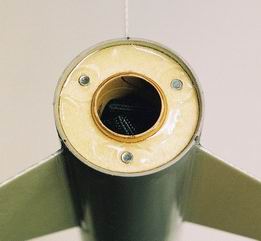 The last part of
step 4 is to glue the lower centering ring in place. I included three #6 blind
nuts (less than $1 from Home Depot) on this ring for motor retention. I filled
in the threaded portion of the blind nuts with Vaseline to protect them from
the epoxy before I glued them in place. This kit does not include any form of
motor retention, but the instructions point you to the PML website for some
additional information.
The last part of
step 4 is to glue the lower centering ring in place. I included three #6 blind
nuts (less than $1 from Home Depot) on this ring for motor retention. I filled
in the threaded portion of the blind nuts with Vaseline to protect them from
the epoxy before I glued them in place. This kit does not include any form of
motor retention, but the instructions point you to the PML website for some
additional information.
Step 5 - Building the piston. This is made from a piece of tube coupler, a ply bulkhead, and a chrome D ring. I used a staple gun to fasten the piston strap to the bulkhead before bonding it with epoxy. The PML piston system is an effective method for recovery ejection. Some recovery wadding on top of the motor is still recommended to protect the piston strap. PML also has some recommendations on the ejection charge size needed for the piston system. Step 6 - Attaching the parachute to the shock cord. The shock cord is a long piece of tubular nylon. Instead of attaching the chute directly to the shock cord, I just tied a loop in the shock cord and attached a large snap link to the chute, making it easily replaceable. Specific instructions are included showing how to tie knots in the tubular nylon. Step 7 - Tying the shock cord to the D ring. Again, I made a loop and used a snap link making the shock cord easily replaceable.
Step 8 - Tying the shock cord to the nose cone.
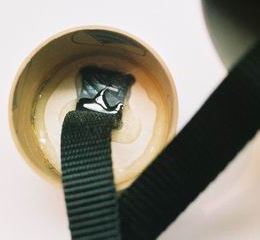
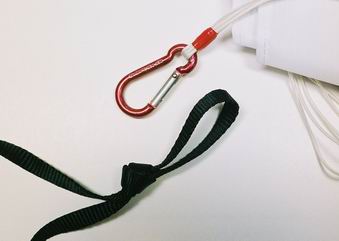
Step 9 - Mounting 2 brass launch lugs to the airframe. I have some concerns about gluing brass tubing onto plastic tubing; it just seems prone to failure. I roughed up the brass and the airframe as indicated in the instructions, and made substantial fillets. A small strip of fiberglass could be used to reinforce this; however, something like Acme Conformal lugs might be the best solution.
The instructions give some suggestions for painting and finishing and other tips. It also references the PML online FAQ. The PML website contains a wealth of information on construction, finishing, motor selection and retention. It's a good resource.
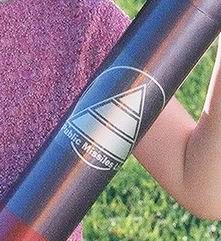 Finishing:
Finishing:
I went with a “system" approach for paint using Rust-Oleum brand
spray from Menards. I used White Sandable Primer, Ruby Red Metallic, Deep
Purple Metallic, and Clear Gloss. The smooth plastic airframe and G-10 fins
allow even a novice to obtain a beautiful finish with very little prep work. I
applied the self-adhesive vinyl “Explorer" decal, and I wondered why
there was no PML logo decal in my kit. A sheet of various size logo decals is
available from PML for $5. I emailed PML to ask why no logo decal was included
and to see if they had a single “scrap" logo decal they could send me
for free as I have no use for a full sheet of decals. I got a quick reply
telling me that the PML logo decal is NOT included in the Explorer kit. (Oh
well, - never hurts to ask) A few days later a “scrap" logo decal
arrived in the mail from PML. That is the kind of customer service that will
help PML retain and grow loyal customers. I was not ashamed to ask for a free
decal, and I am not ashamed to write about it here. The fact that they sent one
tells me that PML is a customer oriented company.
Pros: Very easy construction resulting in an extremely durable rocket. Well illustrated instructions and a wealth of additional information on the PML web site. The sturdy materials won't be easily damaged in a rough landing. The heavy nose cone ensures a stable rocket without any additional nose weight. The durability of these materials will help ensure successful L1 certification by reducing/eliminating the likelihood of common problems such as zippers etc. It's easy to obtain a beautiful high gloss finish with these materials.
Cons: A heavy, overbuilt rocket for its size. RocSim indicates an over stable 2.75 to 3.31 calibers with an H128 motor installed.
The same size rocket built with, BT-80 tubing, and plywood fins would be about half the weight of this kit. (Imagine an Estes Executioner with a longer body tube)
Construction Rating: 4 out of 5
Flight:
I have yet to fly the finished Explorer. I'm planning to go with an AeroTech SU
G40-7 for the first flight. PML supplies (on their web site) a RocSim file for
this kit which (after tweaking) puts my Explorer at about 1075 feet on this
motor.
The simulation also indicates that the rocket will land at about 16 mph on the stock 30" inch chute. That seems a bit fast to me. PML recommends upgrading the chute to 36" inches for hard surface landings
Recovery:
Pros: Durable materials and a stable design produce a very good L1 rocket with
no special modifications required. The rocket should be able to withstand hard
landings with little or no damage.
Cons: No motor retention included in the kit. Parachute with spill hole may bring the rocket down too hard.
Flight Rating: tbd out of 5
Summary:
This is an easy kit to build and the result is a very durable Mid to Level 1
rocket. Many people have used this kit for L1 certification. This kit would
work well for a beginner looking for L1 certification simplified. Someone
moving up from model-power to high power might suffer a little sticker shock.
Conformal lugs might stay stuck on the plastic airframe better than epoxied
brass. The larger PML 36" chute is a worthwhile upgrade.
Overall Rating: tbd out of 5
 |
 |
Flights
 |
 |
 |
 |
W.A. (February 11, 2004)